The winter brook trout angler is a breed apart: part dreamer, part adventurer, and as often as not, part unwilling realist.
Serious winter speck anglers know the risks of the game. Just because you hike a mile through the bush, scale a small mountain, and then rappel down a cliff to reach a remote trout lake away from other anglers doesn’t mean you will catch fish.
Brook trout are temperamental at the best of times. Some days they feed as if it’s their last meal, other times they seem completely uninterested in anything.
These Jekyll-and-Hyde characteristics are compounded by the onset of winter. Yet, compared with fish like walleye and panfish, brook trout are cold-water creatures and remarkably active under the ice.
In the winter, they never stop eating. Although their appetites might be a bit suppressed in winter, they stay near food. In most brook trout lakes and ponds, being near food usually means being near shore. In some instances, trout will be in water so shallow that they can barely squeeze under the ice.
As with most winter angling, locating brookies is the biggest hurdle. In fact, it’s almost the whole game.
There are seldom nearly as many trout in a lake as you might think, so this means you need to key in on the very best locations and thoroughly fish them.
Here are some tips to finding hot spots and some and new techniques to try out.
1. Beaver house
This spot is prime for many reasons. Despite a foot or more of ice overhead, winter brook trout love cover. For brookies, this is a great place to elude predators such as otters, but is also a source of food.
Minnows will congregate around the beaver house and be magnets for trout. Stickleback, a favourite food of brookies, are especially fond of the maze. There will also be aquatic insects, leeches, and amphibians.
Keep in mind the same sticks and logs favoured by brook trout are a huge headache for anglers. Many big winter brookies have been broken off on the wood. Also, watch for holes and weak ice caused by trapping activities around beaver houses.
The cabbage weedline around a beaver house will also be full of insects and visited by feeding brook trout from time to time. Fish the deep edge of the weedline with a jigging spoon or small jig and tube body or minnow.
2. Rock point
This spot has potential for both size and numbers of fish. However, it can also leave an angler wondering who flushed all the brook trout out of the lake. Focus on the bald rock point. This obvious location is close to water that’s a bit deeper than some other portions of the lake.
The point itself might hold fish, but has little structure other than the bald rock to hold fish. This doesn’t mean there won’t be trout here. Points and trout are very compatible, even if it’s just as a parking spot between feeding forays. Yet, the lack of plentiful food means it won’t hold large numbers of fish for long periods of time.
3. Rock wall
This is the least obvious spot on the lake. In fact, few if any traditional speck anglers would likely fish it. Cliffs are not usually great brook trout areas, but they can hold fish. Generally, they will be relatively tight to the wall and in deeper water.
A deep rock wall is a prime spot to aggressively jig a spoon such as the Swedish pimple or hopkins. These deeper, more open-water brookies are likely keying in on minnows and, depending on the lake, cisco or even introduced smelt.
Jig the spoon hard and watch for hits as it drops. A big brook trout can crank a spoon every bit as hard as a lake trout. This is not light-line fishing.
4. Depth transition zone
This is another complex area with potential. A beaver house and nearby dam ensure lots of food and cover for trout. This beaver house also edges on deeper water, which means there’s a good possibility of big fish hanging around.
The deep hole rimmed by aquatic vegetation (cabbage weeds) is also a potential buffet for brookies. Drill a hole or two over the deep water and jig a spoon or bucktail jig. Work the flat at the mouth of the outlet, as well.
5. Boulder flat
This is a subtle spot that most anglers will likely miss. The boulder flat is not quite as large as the one across the lake, but it still has possibilities. The point is not as sharp and doesn’t break into deep water, but this might be a plus, as it’s located close to one of the most productive feeding areas in the lake.
More trees down along the shore add to the overall draw of this spot. It’s definitely worth trying, especially if other areas have already been hit by other anglers. It can be your ace in the hole.
6. Weed flat
This is the most productive part of the lake for winter brookies, but once again is not obvious.
The large shallow bay is lined with floating bog and Labrador tea. It really doesn’t look like much under a foot of ice and snow. Yet, for brook trout, this weedy flat is a virtual fast-food drive-through. Instead of Big Macs and Whoppers, stoneflies, dragonflies, mayflies, caddis flies, scuds, and all sorts of other goodies are being served.
These soft muskeg bottoms are just loaded with wiggly life, and trout eat it all.
Bait and tactics
Keep brook trout set-ups simple. Set-lines work great on flats, and you should always have one out if the law allows.
Set a line the legal distance from where you are jigging and moving around as brook trout can be quite sensitive to noise.
Most live baits will work, but where allowed, the wiggle of a 2- or 3-inch minnow is hard to beat.
Use a split shot or two coupled with a small treble hook (No. 6. or 4) buried in the back of the minnow. A light red or orange jig head with large-gap hook can also work wonders with a minnow.
An old-fashioned gad (limber willow branch or the like with a line) will work, but many trout anglers prefer a short jigging/spinning rod and a balance to detect hits.
Keep the drag loose so a trout can take line when it hits. You will see the rod tip bouncing and then pull down towards the hole. At the hit, carefully open the bail, tighten the drag, close the bail, and set the hook. Worms are a good bait choice for jigging. Brown, black, and olive marabou jigs sweetened with a taste of worm look much like aquatic insects. Orange marabou is a good attractor, as well.
Jigging with grubs, tubes, and light metal spoons will call in trout from a long way. You can sweeten all of these with a worm or minnow, but there are times when a plain spoon jigged aggressively will work best. Use a medium-action ice-jigging rod and a spinning reel loaded with at least 8-pound test when jigging spoons. Attach the lure with a metal clip and make sure the hooks are sharp.


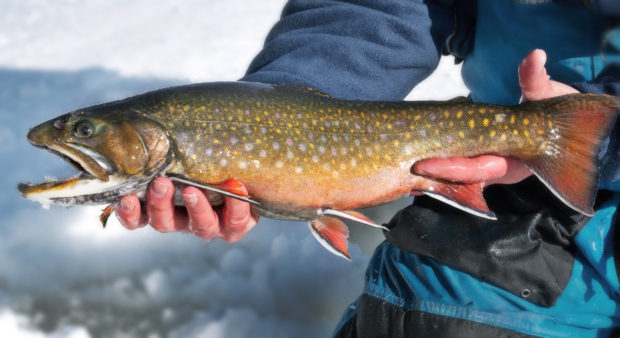
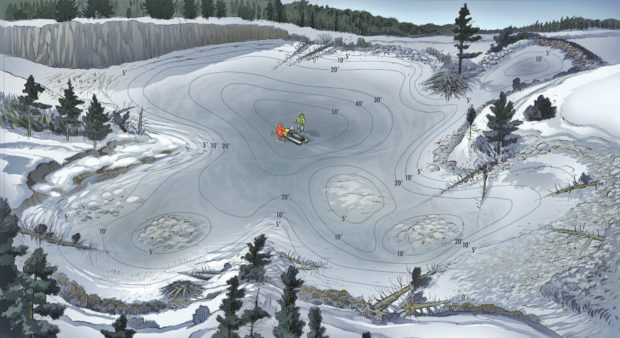
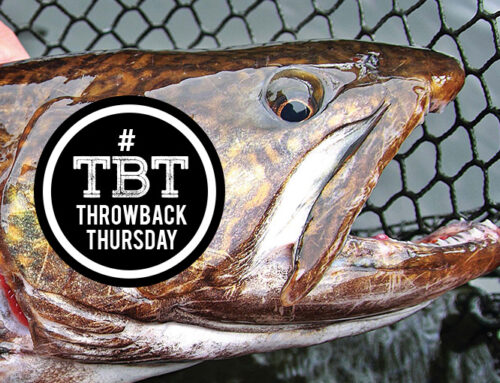
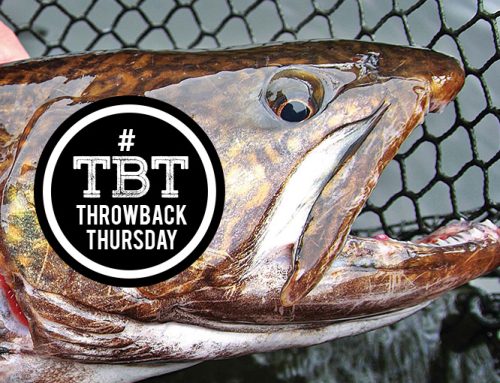
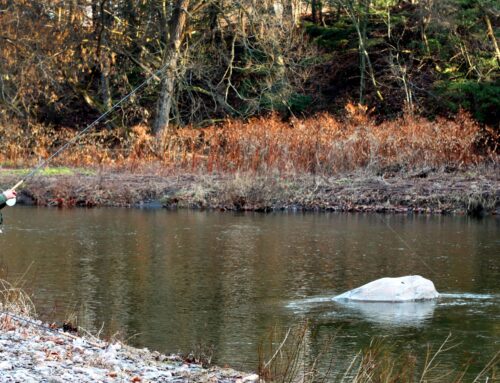
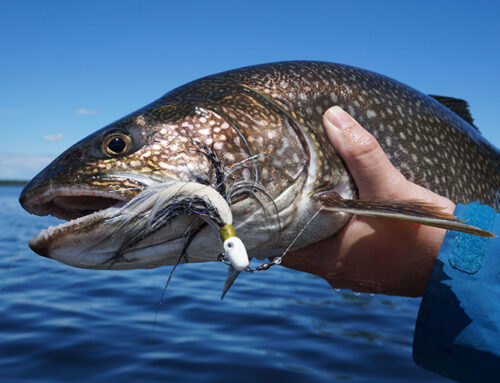
Leave A Comment